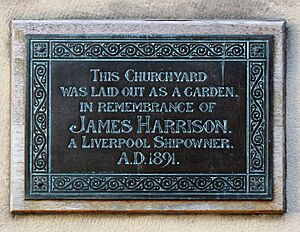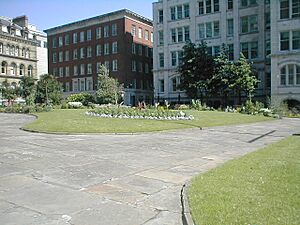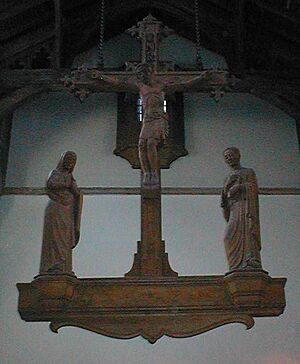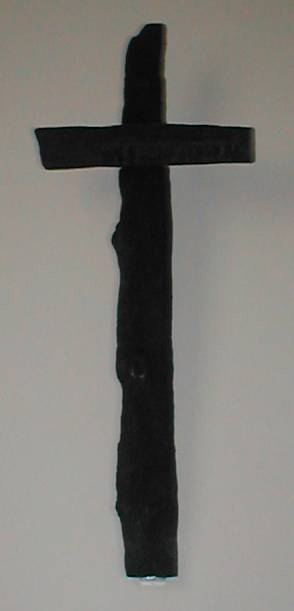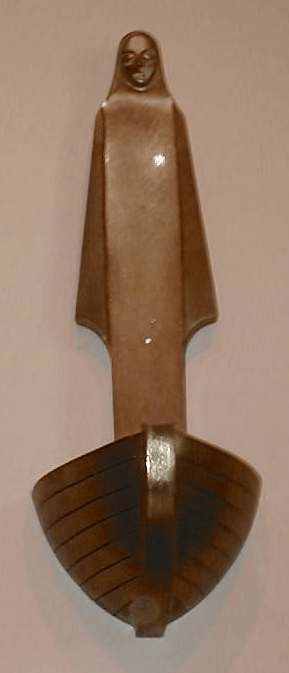Church of Our Lady and St Nicholas, Liverpool facts for kids
Quick facts for kids Liverpool Parish Church |
|
|---|---|
| Church of Our Lady and Saint Nicholas | |
| St Nick's or The Sailors' Church | |
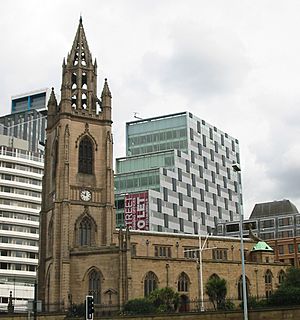
The Church of Our Lady and Saint Nicholas
|
|
| 53°24′25″N 2°59′41″W / 53.4070°N 2.9948°W | |
| Location | Chapel Street, Liverpool |
| Country | England |
| Denomination | Church of England |
| Churchmanship | Modern Catholic |
| History | |
| Consecrated | 1952 (current church) |
| Architecture | |
| Architect(s) | Edward C. Butler (church) Thomas Harrison (tower) |
| Years built | 1811 (tower) March 1949 (church) |
| Completed | 1815 (tower) 1952 (church) |
| Administration | |
| Parish | Liverpool |
| Deanery | North Liverpool |
| Archdeaconry | Liverpool |
| Diocese | Liverpool Diocese |
| Province | Province of York |
The Church of Our Lady and Saint Nicholas is the main Anglican church in Liverpool. People have worshipped here since at least the 1250s. The church is very close to the River Mersey and the Pier Head. It is often called "St Nick's" or "The Sailors' Church" because St Nicholas is the patron saint of sailors.
The church is a Grade II listed building. This means it is an important historic building. It is an active church in the Liverpool Diocese. From 1813 to 1868, its tower was the tallest building in Liverpool.
Contents
Early Beginnings: St Mary del Quay
In 1207, King John gave Liverpool its special charter. By the 1250s, a small stone chapel called St Mary del Quay was built. This was the first place of worship on the church's current site. It likely stood near where the tower is now, looking over a quay on the River Mersey.
This chapel was the main place of worship until 1355. Then, a new, larger chapel was built. It was dedicated to St Mary and St Nicholas. Building this new chapel took more than 100 years to complete.
Changes Over Time
In 1361, a terrible plague affected the town. The Bishop of Lichfield and Coventry allowed a burial ground to be used. The chapel was officially opened the next year. By the late 1400s, a north aisle was added. This made the church bigger.
Four special altars, called chantries, were also built. Rich people paid priests to pray at these altars.
The Church Through the Years
During the English Reformation, the chantries were removed. The church building was changed to fit the new style of worship. Between 1673 and 1718, the church was made even larger. Galleries were added to hold more people as Liverpool's population grew. A tall spire was added in 1746.
In 1699, Liverpool became its own parish. It was unusual because it had two main churches: Our Lady and St Nicholas (the "Old Church") and St Peter's. In 1775, the church walls were rebuilt. The galleries stayed because people paid to sit in them. A new roof was put on top of classic-style columns.
By 1865, there were 27 churches in the parish. Since 1916, Our Lady and St Nicholas has been the main Parish Church of Liverpool. St Peter's Church was taken down in 1922.
A Sad Accident
Over the years, the "Old Church" continued to be used. People often warned that the spire was not safe. On Sunday, February 11, 1810, a terrible accident happened. As the bells rang for morning service, the spire fell into the church below. Twenty-five people died, and 21 of them were under 15 years old. Most were girls from a charity school. The church bells were also destroyed.
Between 1811 and 1815, a new tower and lantern were built. Thomas Harrison designed the new tower. The last parts of the old St Mary del Quay chapel were removed. New bells were put in the tower.
Over time, small changes were made to the church. The Parish Centre was built in the 1920s for community events and a church school. The church stayed mostly the same from 1815 until 1940.
Churchyard Changes
The churchyard used to have walls around it. From 1758 to 1772, guns were placed in part of the burial ground to protect the river. Until 1767, the River Mersey reached the church garden walls at high tide. In 1849, people stopped being buried in the churchyard.
In 1891, the churchyard became a public garden. It was made in memory of James Harrison. His shipping company had offices facing the churchyard for many years.
Destruction and Rebuilding
During World War II, the church bells were taken down for safety. Sadly, they were never put back up. On December 21, 1940, a German air raid destroyed the main part of the church by fire. Only the parish rooms, vestries, and the 19th-century tower remained.
Rebuilding started in March 1949. The new church was finished and officially opened on October 18, 1952. New bells were made for the church.
Edward C. Butler designed the new church. He made some big changes. Usually, the altar is at the east end of a church. But Butler placed it at the western end. He also made the sanctuary (the area around the altar) the most important part. The new church did not have galleries, which meant fewer seats. This was because fewer people attended church at that time. The main part of the church, called the nave, was made much taller.
Inside and Out
The church's outside has a special lantern spire. You can easily see it from the river. Inside, the church has beautiful wooden carvings of vines. This reminds people of a Bible verse: "I am the vine, you are the branches."
In one corner, there is a stained glass window. It shows Our Lady and St Nicholas holding a ship. A message on the window says: "For the Healing of the Nations." A memorial for the Cunard Steamship Company is also in the church. The church organ is dedicated to Charles W. Bridson, who was the organist for many years.
Above the altar, there is a large carving called the Rood. It shows Christ with Our Lady and St John. This Rood was carved from old oak wood that used to be part of the bell frame in the tower.
The rebuilt church has two chapels. The Chapel of St Peter is on the south side. It remembers the old St Peter's Church. An 18th-century wooden table from that church is now the altar here. This chapel is used for weekday services. A cross on the wall is made from burned wood from the old church.
The other chapel is the Maritime Chapel of St Mary del Quay. It was opened in 1993. This chapel remembers the old medieval shrine. It has a bronze statue of Our Lady standing on the front of a boat. This statue was made by Liverpool artist Arthur Dooley. The chapel also has a Book of Remembrance, which lists the names of sailors lost at sea.
Behind the main altar, there is a painting of the crucifixion. It was painted by Tatiana Nichita. This painting was given to the church to remember a police officer whose funeral was held there.
The "Dick Docks" Saying
The church is connected to a famous saying: "I'll be waiting till Dick docks." This means "I'll be waiting a very long time." It refers to a ship called the Richard Donnelly, which people say sank in Liverpool Bay. Another version of the saying is "When Donnelly docks!" This is used when someone makes a promise that will probably never happen.
On top of the church tower, there is a weather vane shaped like a ship. It is made of gilded copper and is about 4 feet 4 inches tall. This weather vane likely survived the tower's collapse in 1810. It was repaired and put back up in 1815. Old photos show similar ship weather vanes on other buildings in Liverpool. The vane was first added to the church in 1746.
However, despite these stories, there is no record of a Liverpool ship named Donnelly or Richard Donnelly. The Director of the Liverpool Maritime Museum has confirmed this. So, the story about the ship might just be a local legend!
See also
- Architecture of Liverpool
- List of works by Thomas Harrison



